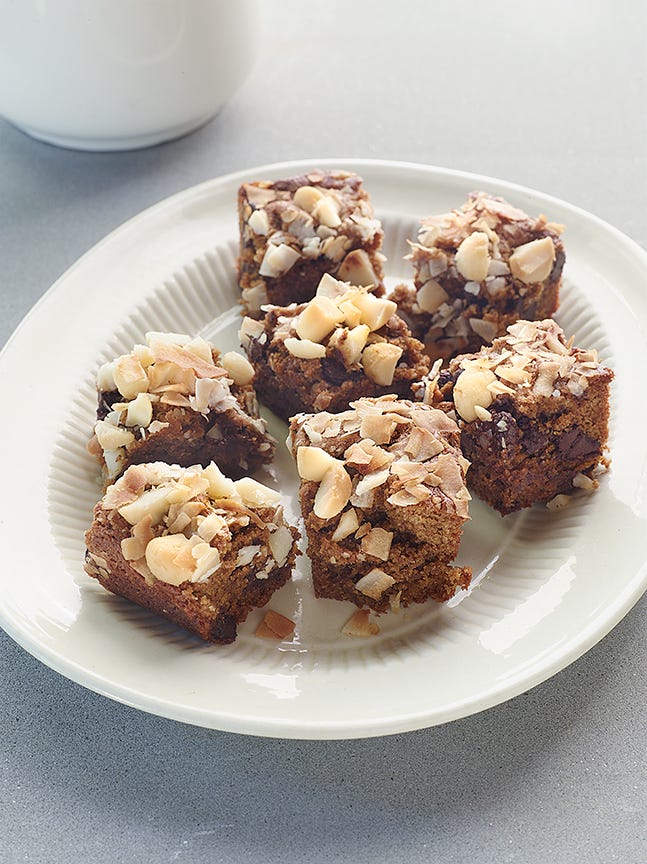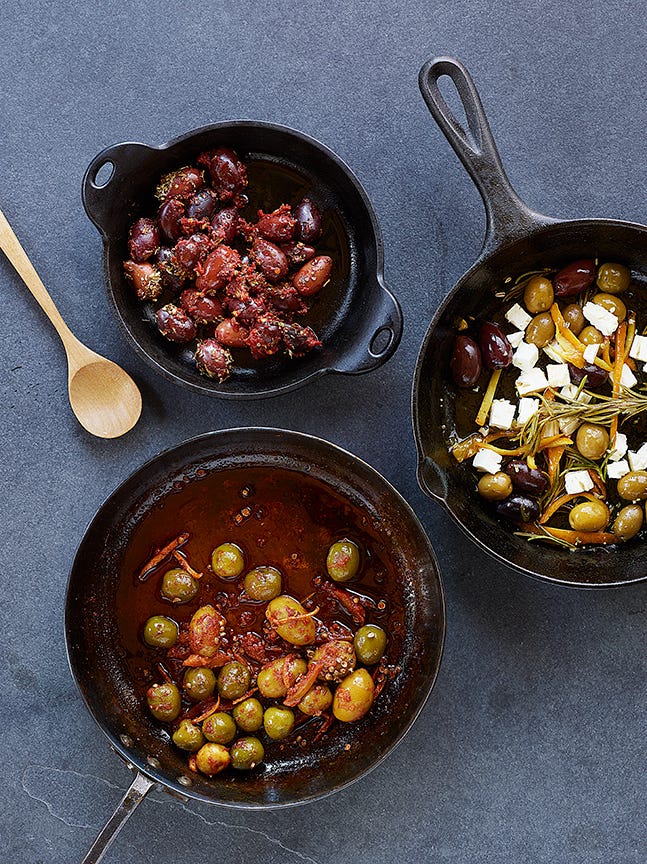A New Way to Think About Dietary Fat and the Brain
Plus, strategic brain-healthy swaps and the May Cookbook Club Menu

Hello, Brain Health Ambassadors. I write today from my mother’s house in San Diego. My mom and I have been doing jigsaw puzzles together, looking at old family photos, and cooking from my book. She really likes the Slow-Roasted Salmon with Avocado Butter on page 169. In fact, the avocado butter is based on a dish she used to make when I was growing up. We’ve also made the Creamy Tomato Soup on page 120 twice. And today, I am stocking the freezer with single portions of the Easy Greens Smoothie (page 108) to help make it easier for her caregivers around mealtime.
If you’ve been reading my newsletter for a while, you may recall that my mother has Alzheimer’s. One of the first things we did as a family when she was diagnosed was to get rid of the brain-harming foods in her diet. In 2015, there was already solid evidence that a diet full of saturated and trans fats accelerated the path to Alzheimer’s. Since my mom was in the mild cognitive impairment stage then, my siblings and I were motivated to do anything to slow the process. Now, eight years later, she is declining but still able to live in her home with help. We are just starting the process of looking into memory care.

On Friday, I’ll be writing to you about how we approached the pantry clean-out, and some of the sneakily processed foods we found there. But for today’s newsletter, let’s examine what we know about the optimal fat content of a brain-protective dietary pattern. Fat is the last of my 4F’s of Brain Healthy Food we’ve been discussing over the last few months.
Clearing up some confusion about fats
Americans have gone through phases of fearing fats, avoiding fats, and then, with the keto fad, eating entirely too much of them. As a result, it’s understandable that many people are confused about fats. It doesn’t help that food companies market products that are high in saturated fat (like MCT oil and other keto-friendly foods) as good for the brain, despite the fact that these claims are not supported by science.

There are three types of fats
Unsaturated fats. These are the best fats for your brain. I call them the Brain-Friendly Fats, and they are one of my 4F’s of brain-healthy food. Read about the other F’s here. Both mono- and polyunsaturated fats are unsaturated—they have one or more double bonds and more flexible structure than sat fats. Monounsaturated fats are found in nuts and seeds, avocados, olives and olive oil, whole grains, and many other brain-healthy foods. Polyunsaturated fats come from fish and seafood, walnuts, sunflower seeds, and some cooking oils. The polys include two critical omega-3 fats—DHA and EPA. Both are essential for brain health, meaning the body can’t make them. The only way to get these fats is from food or supplements (such as fish or algae oil). A brain-healthy diet should provide 80% of calories from monounsaturated fats and about 15% from polyunsaturated ones.
Saturated fats. These are the fats found in whole-milk dairy products (butter, cheese and cream), coconut oil, red meat, and many processed foods. Not all saturated fats are bad, but a brain-healthy diet should keep the total amount of calories from these fats under 5%. (The typical American diet gets about 30% of calories from sat fats.) The problem with saturated fats is that they are directly inflammatory to blood vessels, especially the delicate ones that supply the brain. Plus, a diet laden with saturated fats leads to more harmful blood cholesterol, especially low density lipoprotein (LDL), also a risk factor for Alzheimer’s. Consuming saturated fats in the presence of refined sugars, like most standard American diet eaters do, is a recipe for even worse inflammation.
Trans fats. These are the least healthy fats, found in ultra-processed foods like cake, cookies, crackers, frozen pies, processed cheese and meat, and snack foods like microwave popcorn. These are unsaturated fats that have been processed to have more hydrogen molecules. This “hydrogenation” process is used by the food industry to extend shelf life by making fats less prone to rancidity. Trans fats provide no benefits to human health and are not essential. In 2018 the Food and Drug Administration banned food manufacturers from adding partially hydrogenated oils to foods but they can still be found in some foods.
A new way to think about dietary fats and the brain

Instead of labeling fats as “good” or “bad,” consider what they can do for your brain health. For example, DHA and EPA quell inflammation in the brain. They repair age-related damage to brain cells, and actually become incorporated into the cell’s protective sheaths. These fats are so key to brain health that a low intake is associated with poor cognitive function with age. A deficiency state of DHA and EPA is associated with an increased risk of Alzheimer’s. Think of DHA and EPA as calming and reparative. They are essential for preventing Alzheimer’s.
Monounsaturated fats help keep the brain humming along at optimal function. These fats provide the building blocks needed to grow new brain cells and a steady supply of the neurotransmitters needed for cell to cell communication. Think of mono fats as boosting neuroplasticity. The fat content of a brain-healthy diet is mostly monos.
Saturated fats provide energy for cell functions, building blocks for hormones, and aid in the absorption of key fat-soluble nutrients like vitamins D, E, A, and K. But your brain only needs a small amount of these fats to thrive. Overconsumption can lead to problems like atherosclerosis (hardening of the arteries), a common cause of heart attack and stroke, and a major risk factor for Alzheimer’s disease. Think of sat fats as energy-boosting building blocks. A small amount is all you need.
The powerful impact of swapping in more brain-healthy fats
What happens when you swap in monos and polys for sat fats? In this 2022 study out of Harvard, researchers evaluated health outcomes based on the types of fats in the diet. Participants with the highest level of consumption of olive oil (providing mostly mono- and polyunsaturated fats) had the lowest risk of dying from any cause. Those in the highest category of olive oil consumption (more than 7 grams/d) had a 19% lower risk of total and cardiovascular mortality. They had a 17% lower risk of cancer mortality. And, they had a 29% reduced risk of dying from a neurodegenerative disease, such as Alzheimer’s or Parkinson’s.
This study shows how swapping in brain-friendly fats for brain-harming ones can have a huge impact on overall mortality. They found significantly lower mortality overall by substituting just 10 grams per day (about 2 teaspoons) of margarine, butter, mayonnaise, and dairy fat with olive oil.
The bottom line: the brain healthy diet is not a low fat diet, but it is very low in saturated fats.
Mono- and polyunsaturated fats make up about 95% of the fats in the two most successful brain-protective diets—the Mediterranean and MIND diets. The fat content of a brain-protective dietary pattern is mostly monounsaturated fats (about 80%), with some polyunsaturated fats (about 15%), and a smaller proportion of saturated fats (5% or less).
May Cookbook Club
Pizza-Spiced Snacking Olives
Grilled Shrimp Skewers with Asparagus and Quinoa-Pecan Pilaf
Roasted Strawberries with Almost Instant Cashew Cream
These recipes have become MVPs in my cooking classes. The Pizza-Spiced Snacking Olives (page 232) receive a warm welcome wherever they go. (Olives, by the way, are an excellent source of monounsaturated fats.) The Grilled Shrimp Skewers (page 195) have been universally loved, and they make good use of the asparagus just coming into season. Vegetarians and vegans: make this with seitan or tofu instead of shrimp. For dessert, let’s celebrate strawberry season with the Roasted Strawberries (page 75). In an upcoming newsletter, I’ll share a video of how to make cashew cream.
I can’t wait to see all your photos! Be sure to email them to me or tag me on Instagram. Some of you have made it a goal to cook each menu every month.
In case you missed it, the BHK Cookbook Club is a way for us to share a monthly seasonal menu from The Brain Health Kitchen: Preventing Alzheimer’s Through Food. Both free and paying subscribers are welcome to cook along. Learn more about how it works here.
Book Tour Update
I can hardly believe it myself but this week is the last leg of the BHK book tour. (Hello San Francisco bay area friends!) I have been on the road since January criss-crossing the U.S. to share the book, cook with you all, and spread the word about how to eat to take care of your brain. I am especially grateful for all of you who have been sending me encouraging messages. Thank you for helping me stay connected during this busy time. Thank you for reading, staying in touch, and taking the best care of your brain.
Love,
Annie
PS: In case you are looking for a Mother’s day gift, my book is on sale this week on Amazon. Also, there is still time to join this giveaway happening on Instagram. Perhaps your mom would appreciate a gift subscription to the BHK newsletter? I would be elated to be bringing brain health news to all the moms out there!





Thank you for your reply. That’s helpful! My LDL is low but my husband’s is high so I guess I should cut back :)
Should different kinds of saturated fats - medium-chain vs long-chain be thought about differently? As someone who is lactose intolerant, I often substitute coconut milk/cream /yoghurt all of which are high in saturated fat but have predominantly medium-chain fatty acids. I have read that medium-chain fats are absorbed differently. Coconuts are also connected with several health benefits, including potentially in relation to cognitive function.